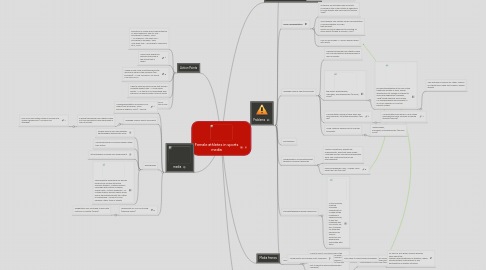
1. Action Points
1.1. education of media about huge potential: In-arena audience: 35% to 45% - according to Lopiano, 2000 • TV audience: 41% share USA - according to Andrews, 1998 40% share Italy - according to Capranica et al., 2002
1.2. Make visual where the grievances are like in the article that is linked
1.3. Speak up like Lizzie Armitstead did after winning a medal in the Guardian (link provided) => USE MOMENTS OF FAME FOR CRITICISM
1.4. It has to become more normal that women compete against men => more mixed events => so that it is not something alien anymore if a woman beats a man at sports
1.5. US and THEM mentality has to be highlighted => in gender just as in race
2. media
2.1. Underrepresentation of women in all media (Fink & Kensicki, 2002; Billings & Angelini, 2007) - see link
2.2. language used by sports journalists
2.2.1. is being transferred from athletic arena into role perceptions and hierarchies in real life society
2.2.1.1. Don Imus calls Rutger's team in WNBA final "nappy-headed hos" (YouTube Link attached)
2.3. photographs
2.3.1. studies have found: male athletes photographed significantly more
2.3.2. capturing women in passive manner rather than active
2.3.3. attractiveness is valued over achievement
2.3.4. Predominantly advertising for beauty products by visually attractive Olympic athletes - Pantene made a campaign with Natalie Coughlin, Gisela Dulko, Victoria Pendleton - all of them typical "perfect sports body" and by advertising beauty the "other" is emphasised - no harm to men because "other" type of athlete
2.4. harassment by ONLINE trolling (example linked)
2.4.1. Weightlifter Zoe Smith had to deal with criticism on Twitter (linked)
3. "girl on girl" crime - female athletes being criticised by their female competitors or female spectators (Gabby Douglas - see link)
4. Problems
4.1. objectification
4.1.1. Gabby douglas hair debate
4.1.2. Emphasizing feminine traits - protecting female athletes from being portrayed as too masculine?
4.1.3. Female first, athlete second - I.e. Gabrielle Reese, Anna Kournikova
4.1.4. Weight criticism of an Australian Olympic swimmer (see link)
4.2. under-representation
4.2.1. In general, an estimated 95% of sports coverage in the United States is dedicated to male athletes and men’s sports (Kinnick, 1998).
4.2.2. The audience may see this under-representation of female athletes as a sign that women’s sports are not as significant or exciting as men’s sports (Knight & Giuliano, 2001).
4.2.3. Lack of role models = Lack of women going into sports
4.3. language used by sports journalists
4.3.1. is being transferred from athletic arena into role perceptions and hierarchies in real life society
4.3.2. talk about “dating habits, marriages, and pregnancies” (Duncan, 2006)
4.3.2.1. By depicting athletes in the role of the traditional mother or wife, female athletes are not viewed as a threat to masculine hegemony (Daddario, 1998) Image example: Kerri Walsh, US beachvolleyball gold medalist in an ad for Pampers USA as the perfect mother.
4.3.2.1.1. This portrayal of women as “other” lessens any threat men might feel toward a female athlete.
4.3.3. Commentators asking if there were "any diva moments" yet at the gymnastics (see link)
4.3.3.1. Commentators focusing on "luck" when describing success formulae of female athletes (see link)
4.3.4. Using Maternal References to Maintain Femininity
4.3.4.1. “dating habits, marriages, and pregnancies” (Duncan, 2006)
4.4. photographs
4.5. marginalisation of everything that threatens dominant hierarchy
4.5.1. Martina Navratilova, despite her achievements, didn't get equal media coverage and her commercial possibilities were very limited because of her homosexuality.
4.5.2. reinforcing gender rules - "Thanks Mom" advert by P&G (see link)
4.6. strength/weakness gender references
4.6.1. In this example, a female Olympian missing out on a medal at the marathon is showed crying, it says the marathon was too "brutal" for her. It focuses on attributes perceived as female - emotions and weaknesses associated with them.
4.7. less sponsorship
4.7.1. a recent report commissioned by the Women’s Sport and Fitness Foundation found that only 0.5% of all commercial sports sponsorship goes to women’s sports while 61% goes to male sports (and the rest to sports in which both genders compete),
4.7.1.1. Japanese and Australian Olympic teams flying economy while their male counterparts fly first class (linked)
5. Olympics 2012
5.1. Biggest discussion in London: gender verification
5.1.1. Ye Shiwen: If she had competed with men, she would've BEATEN a lot of them => threat to patriarchal society => allegations: she MUST be DOPING or be a man
6. Media frames
6.1. Young adults and children most vulnerable
6.1.1. More likely to adopt biased messages
6.1.1.1. As early as first grade, children develop ideas about the “gender-appropriateness of athletics,” which influences their “perceptions of and participation in athletic activities”
